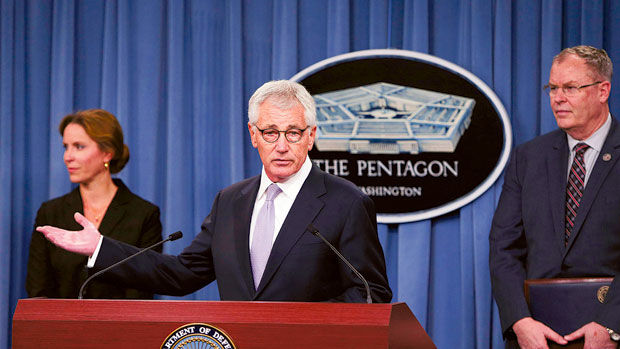
Washington: Defence Secretary Chuck Hagel ordered the military on Wednesday to improve access to treatment, quality of care and patient safety at its hospitals and clinics, giving underperforming hospitals four to six weeks to show how they will address shortcomings.
At a Pentagon news conference, Hagel said that the military’s 54 hospitals and hundreds of clinics in the United States and abroad deliver care that is comparable to that of an average civilian system.
“But we cannot accept average,” he said.
In three pages of directives to the heads of the armed services, he ordered efforts to improve a system that outside experts described as awash in mediocrity, with pockets of excellence and trouble spots. By the end of the year, he said, the department will have a concrete plan for “the top performing system we all want and expect it to be.”
Hagel’s directives hew to the findings of a 645-page report that a panel of military and civilian experts produced after the secretary ordered a comprehensive review of a system that serves 1.35 million active-duty service members, as well as millions of family members and others. The study, released on Wednesday, was motivated by a scandal over access to treatment in a separate hospital system managed by the Department of Veterans Affairs, and by months of inquiries by The New York Times into the quality and safety of military medical care.
Senior Defense officials stressed that the examination did not uncover a crisis in care. In general, the system “provides good quality of care that is safe and timely,” the review found. Nonetheless, nearly every hospital failed to meet at least one benchmark for quality, safety or access to treatment, officials said, and will be forced to show improvement.
Access to care was deemed generally good, although in about one-fifth of military hospitals, patients who need acute care — but not emergency treatment — cannot get an appointment within 24 hours, the review found.
The review levelled more serious criticism at the quality of care, describing it as “mixed.” Echoing a finding reported by The Times in June, the report said that while infant mortality rates are low at military hospitals, babies are more likely to be injured during birth and mothers are more likely to suffer haemorrhages after childbirth than at civilian hospitals.
It also noted higher-than-expected rates of surgical complications at more than half of the military hospitals whose data was most recently submitted for outside review, although death rates of surgical patients fell within the expected range. That finding was also previously reported by The Times.
The review did not address a separate, continuing effort to streamline the military hospital system, in order to save money, better employ medical workers and reduce risks to patients. The Pentagon is trying to convert at least eight underused hospitals into outpatient clinics but is facing political resistance.
In an assessment that officials described as especially troubling, the study released Wednesday found that some military medical workers are afraid to report safety problems for fear of retribution, raising the possibility that lapses or mistakes in treatment have gone unnoticed.
“That piece of the report frankly worried me a lot,” Lt. Gen. Thomas W. Travis, the surgeon general of the Air Force, said in an interview. “When I saw fear of retribution — that is something we just can’t tolerate.”
The Times reported in June that the system suffers from persistent lapses in patient safety, including the failure of hospitals to conduct the required safety investigations in many cases where patients unexpectedly die or suffer severe injury. From 2011 to 2013, for example, medical workers reported 239 unexpected deaths, but only 100 inquiries, called root cause analyses, were forwarded to the Pentagon’s patient safety centre.
The review recommended rewriting policies to eliminate differing interpretations on when such inquiries are required and to ensure that lapses are corrected. And it also endorsed more sophisticated methods to identify breaches in patient safety, such as studying randomly selected patient files for known indicators of unsafe care, a technique used by some leading civilian health care organisations. Otherwise, there will likely be “frequent, significant events that surprise the system and its leadership,” one outside expert noted.
Pamela F. Cipriano, the president of the American Nurses Association, described the need to strengthen patient safety as urgent.
“Until rank and file internalise their roles in promoting safety and preventing harm, performance will be mediocre,” said Cipriano, one of six experts involved in the review.
Reviewers assembled a huge amount of data on military hospitals and clinics as well as conducting site visits and, where possible, comparing the military’s network of hospitals and clinics to three civilian ones.
In general, they concluded, the military health system needs to be more rigorous in how it assesses its own performance. While it collects a wealth of data, the review stated, the military lacks a set of system-wide metrics and methods of analysis that can guide decisions about quality of care or patient safety.
Dr. Peter J. Pronovost, another expert involved in the review, said that like many civilian health care organisations, the military is better at the financial management of health care than oversight of quality of care or patient safety.
“This is not unique to them. If you miss your budget, within a week you are in someone’s office,” said Pronovost, the senior vice president for patient safety and quality at Johns Hopkins Medicine. “We have not applied that kind of rigorous discipline to quality and safety.”
He also said that the military appeared geared toward ensuring that its health care was not inferior to civilian health care, rather than insisting on superior care. “The culture around safety, quality and access seems to be one of mediocrity rather than one of national leadership,” he said in written comments.
Hagel said he will receive regular updates to ensure progress toward “systemwide improvement” is made. He has also ordered that the department make public all available data on military health care, a step officials said would strengthen accountability.
The review concluded that more data is needed to fully evaluate care. For example, the American College of Surgeons analyses surgical outcomes at only 17 military hospitals, even though the rest of the hospitals conduct two-fifths of the military’s surgeries. Woodson said the Pentagon would work with the surgeons’ group to broaden the outside review.
It also found military has fallen behind civilian organisations in studying death rates of patients to improve care. An initial effort by the Defense Department at analysing all deaths, adjusted for risk of illness, identified only four military hospitals with higher-than-expected mortality rates.
Death rates analysed by specific medical conditions are a more useful way to spot substandard care, senior defence officials said. At the major military hospitals, death rates of patients from pneumonia, strokes and heart attacks typically fell within the expected range in the past three years. But half of the time, more patients than expected died of congestive heart failure.












